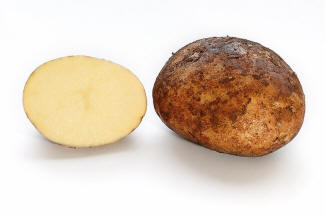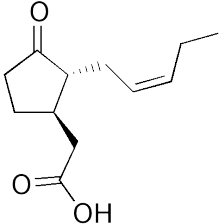▪ Ethylene ▪ Strigolactone ▪ Gibberellin ▪ Brassinosteroid ▪ Abscisic Acid ▪
Hormone
Jasmonic acid/Jasmonate

JA prompts plants to store excess sugar in tubers like the Potato - a Wikimedia commons image
Chemical Structure

Speculative Overall Role
Sugar abundance signal
What is jasmonic acid's speculative
complementary deficiency signal?
Gibberellin/Brassinosteroid
If overall speculative role is
true, where, when and which
cells should synthesize
jasmonate?
If the speculations are true, it would suggest jasmonic acid would be made more in the shoots than the roots. The finding that wounding causes the release of Jasmonic acid might be explained in terms of a rise in intercellular sugar due to ruptured cell contents releasing sugar and catabolic enzymes which would further break down cellulose and other sugar containing molecules.
If overall speculative role is true, what should exogenous jasmonate treatment produce?
Should induce GA, because JA up regulates various processes limited by sugar levels. Exogenously applying JA leads the plant to falsely believe that it has high levels of sugar, thus engaging all sorts of reactions that use sugar, thus further depleting what may simply be a homeostatic level of existing sugar and moving this level into the deficiency range.
If overall speculative role is true, what
should jasmonate inhibit and stimulate?
Should Induces new root growth, just like auxin. If auxin is also present, JA should inhibit shoot growth because high JA and IAA levels are an indication of at least a short term lack of need to expand the shoots.
If overall speculative role is true,
how should jasmonate affect storage?
Should cause sugar to be stored in proteins and tubers for less propitious times.
If overall speculative role is true,
how should jasmonate be transported?
May be expected to travel in the direction of the roots, away from the shoots and particularly the shoot meristems. Regions of a cell or tissue or plant part that contains high JA, may particularly attract sugar and transport of sugar may follow active JA transport down a plant.
If overall speculative role is true, how should
jasmonate affect attraction and repulsion?
Should attract all nutrients and abundance signals to a cell and repulse deficiency signals.
If overall speculative role is true, how
should jasmonate affect apical dominance?
Should induce shoot apical dominance along with auxin, however the possibility exists for two dominant apices if one is particularly good at sugar production (in the light) and one good at oxygen harvesting (in the wind). May break root apical dominances under conditions of low CK and SA.
If overall speculative role is true, how
should jasmonate affect Cell Division?
Is actually necessary for cell division along with auxin, cytokinin and Salicylic acid. If there are some plant callus lines that will divide with only auxin and cytokinin present it is because these cell lines are mutants that produce SA and JA natively, or these other hormones are unknowingly being included with the "other" nutrients/vitamins that are also added to calluses to get them to divide.
If overall speculative role is true, how
should jasmonate affect senescence?
Should protect plant tissue from senescence, particularly root tissue.
If overall speculative role is true,
how should jasmonate effect growth
directions to provide balance in the plant?
Because ET and IAA show complementary growth patterns with ET broadening and IAA lengthening and the same is true for CK (broadening) and BR (lengthening), we might expect that JA should show a complementary growth pattern to GA's cell lengthening, thus JA should broaden cells and plant tissue.
Proven Synthesis and Transport
- JA exist at high levels in flowers and developing pericarps. 13 Why this makes sense - flowers have high amounts of sugar available in order to produce nectar.
- JA exist at high levels in the chloroplasts of illuminated plants. 13 Why this makes sense - chloroplast have high amounts of sugar due to photosynthesis.
- JA increases in response to mechanical stress and produce tendril coiling. 14 Why this makes sense - ?? mechanical stress damages cell walls releasing cell contents high in sugar and enzymes that catabolize cellulose? The plant then uses the following jasmonate rise as a symptom needing the response to mechanical stress it normally provides.
- Jasmonate is made in response to wounding. 15 Why this makes sense - bruising and wounding ruptures cells and releases vacuole sequestered sugars. Also neighboring plant cell reaction to wounding may be to release amylases (by inducing GA?) which increases sugar levels in the inter cell spaces.
- Jasmonates levels increase along with those of ABA under desiccation conditions. 19 Why this makes sense - since photosynthesis uses up water and so we'd expect photosynthesis to go down under desiccation, so instead this is the opposite of what the theory predicts. Perhaps the water loss countering measures ABA does in this experiment are enough to actually provide a boost to photosynthesis above the starting level because the amount of water available was a limiting factor.
That being said, excess photosynthesis will cause desiccation for the same reason, so a rise in jasmonate will eventually show a rise in ABA because the process of water use by photosynthesis is tied to its shortage in the plant. However jasmonate should show up then desiccation and then ABA, not in the order suggested by the finding.
Proven Effects
- JA is involved in the tuber storage proteins system and a derivative may stimulate tuber formation. 16 17 Why this makes sense - storage proteins and tubers are induced by JA in order to store excess sugar.
- JA induces chlorosis inhibits photosynthesis gene transcription. 13 Why this makes sense - chlorosis induced by JA, is a negative feedback loop to cannibalize excess photosynthesis machinery. JA is an indication of excess photosynthesis capacity.
- What JA does in flower and fruits is unknown, but it may be involved in the converting green leaf cells contents into seed storage proteins, carotenoid and the sugars. 13 Why this makes sense - fruits and developing seeds may use JA as a signal to stimulate the leaves to send sugar their way and to turn the sugar stream into stored starch.
- JA and ethylene appear to act in tandem to enact plant defense response. 18 Why this makes sense - ?